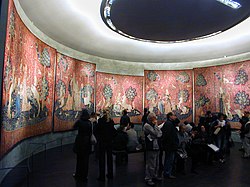
The first stop among many was to the Le musée national du Moyen Âge (the National Museum of the Middle Ages, also called Musée de Cluny). It's one of the most amazing museums I've ever seen. Room after room of medieval artifacts, from pillars to rings, painted statues to stained glass, it was like putting all the medieval things I've wanted to see in one place. I could have spent days there. I'm very lucky that my husband also likes history, because we ended up spending most of the afternoon wandering through room after room of wonders.
Perhaps the most famous objects in the museum are the 'Lady and the Unicorn' tapestries, one of which is pictured above. I didn't realize just
 how huge they would be. The image to the left shows the scale of the tapestries when they are put altogether. When you can see them along the wall, you can see the story progressing from one theme to another. It was quite breathtaking to see the tiny details in each tapestry and how well the tapestry has held up after 500+ years. Even the background is decorated with a floral pattern and little animals, so one could stare for hours at them and always see something new.
how huge they would be. The image to the left shows the scale of the tapestries when they are put altogether. When you can see them along the wall, you can see the story progressing from one theme to another. It was quite breathtaking to see the tiny details in each tapestry and how well the tapestry has held up after 500+ years. Even the background is decorated with a floral pattern and little animals, so one could stare for hours at them and always see something new.My favorite part of the museum was being able to witness something about the medieval period that doesn't really survive in England: painted statues. Medieval churches were gaudy affairs. The tile was painted, the pillars were painted, and all the statuary were painted as well. In England, it's a rare find to see remnants of medieval painting, but the Musee had some amazing examples. This one from the 15th century is nice, but my favorite were the earlier ones from around the 12th century. K. was incredibly impressed with all the medieval stained and painted glass, which is something else one can't see in England very easily.
1 comment:
Wow. That image is amazing!
Post a Comment